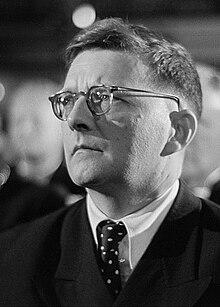Children's Notebook: Difference between revisions
Gerda Arendt (talk | contribs) →References: coll |
m Add link to Galina Shostakovich |
||
| Line 17: | Line 17: | ||
| duration = |
| duration = |
||
}} |
}} |
||
'''''Children's Notebook''''' ([[Opus number|Op]]. 69) is a set of seven [[Solo (music)|solo]] pieces for [[piano]] composed by [[Dmitri Shostakovich]] in 1944–1945. The selections were chosen from pieces written by the [[composer]] to his daughter, Galina Shostakovich, for her piano studies. Only six of them were originally published under this title in 1945 ; the seventh piece ("Birthday", written for his daughter's ninth birthday in 1945) was appended in 1983 to the collection.<ref>{{cite book|first=Laurel E. |last=Fay|title=Shostakovich: A Life|url=https://books.google.com/books?id=UbBAFDCmeEQC&pg=PA193|year=2005|publisher=Oxford University Press|isbn=978-0-19-518251-4|page=193}}</ref> |
'''''Children's Notebook''''' ([[Opus number|Op]]. 69) is a set of seven [[Solo (music)|solo]] pieces for [[piano]] composed by [[Dmitri Shostakovich]] in 1944–1945. The selections were chosen from pieces written by the [[composer]] to his daughter, [[Galina Dmitrievna Shostakovich]], for her piano studies. Only six of them were originally published under this title in 1945 ; the seventh piece ("Birthday", written for his daughter's ninth birthday in 1945) was appended in 1983 to the collection.<ref>{{cite book|first=Laurel E. |last=Fay|title=Shostakovich: A Life|url=https://books.google.com/books?id=UbBAFDCmeEQC&pg=PA193|year=2005|publisher=Oxford University Press|isbn=978-0-19-518251-4|page=193}}</ref> |
||
The sixth piece in the set ("Clockwork Doll") echoes the [[Motif (music)|motif]] used in Shostakovich's first [[Musical composition|composition]], his ''Scherzo for Orchestra in F{{music|sharp}} minor'' (Op. 1). "Birthday" (the seventh piece) begins with a motif which foreshadows the [[fanfare]] motif at the beginning of Shostakovich's [[Festive Overture (Shostakovich)|''Festive Overture'' (Op. 96)]].<ref>{{cite book|first=Laurel E. |last=Fay|title=Shostakovich: A Life|url=https://books.google.com/books?id=UbBAFDCmeEQC&pg=PA149|year=2005|publisher=Oxford University Press|isbn=978-0-19-518251-4|page=149}}</ref><!-- don't use harvard refs --> |
The sixth piece in the set ("Clockwork Doll") echoes the [[Motif (music)|motif]] used in Shostakovich's first [[Musical composition|composition]], his ''Scherzo for Orchestra in F{{music|sharp}} minor'' (Op. 1). "Birthday" (the seventh piece) begins with a motif which foreshadows the [[fanfare]] motif at the beginning of Shostakovich's [[Festive Overture (Shostakovich)|''Festive Overture'' (Op. 96)]].<ref>{{cite book|first=Laurel E. |last=Fay|title=Shostakovich: A Life|url=https://books.google.com/books?id=UbBAFDCmeEQC&pg=PA149|year=2005|publisher=Oxford University Press|isbn=978-0-19-518251-4|page=149}}</ref><!-- don't use harvard refs --> |
||
Revision as of 04:33, 1 April 2022
| Children's Notebook | |
|---|---|
| Piano music by Dmitri Shostakovich | |
 Dmitri Shostakovich in 1950 | |
| Catalogue | Op. 69 |
| Composed | 1944–45 |
| Dedication | Galina Shostakovich |
| Movements | 7 |
Children's Notebook (Op. 69) is a set of seven solo pieces for piano composed by Dmitri Shostakovich in 1944–1945. The selections were chosen from pieces written by the composer to his daughter, Galina Dmitrievna Shostakovich, for her piano studies. Only six of them were originally published under this title in 1945 ; the seventh piece ("Birthday", written for his daughter's ninth birthday in 1945) was appended in 1983 to the collection.[1]
The sixth piece in the set ("Clockwork Doll") echoes the motif used in Shostakovich's first composition, his Scherzo for Orchestra in F♯ minor (Op. 1). "Birthday" (the seventh piece) begins with a motif which foreshadows the fanfare motif at the beginning of Shostakovich's Festive Overture (Op. 96).[2]
The Children’s Notebook was composed by Shostakovich for his daughter Galina, who was then a child and starting to learn piano lessons. The composer promised her that as soon she mastered one piece he would compose another.[3] Shostakovich recorded all of them during the 1947 Prague Spring Festival.[3]
Pieces
- March
- Valse
- The Bear
- Merry Tale
- Sad Tale
- The Clockwork Doll
- Birthday (published in 1983)
References
- ^ Fay, Laurel E. (2005). Shostakovich: A Life. Oxford University Press. p. 193. ISBN 978-0-19-518251-4.
- ^ Fay, Laurel E. (2005). Shostakovich: A Life. Oxford University Press. p. 149. ISBN 978-0-19-518251-4.
- ^ a b Moshevich, Sofia (28 May 2015). Shostakovich's Music for Piano Solo: Interpretation and Performance. Indiana University Press. p. 193. ISBN 978-0-253-01431-3.
